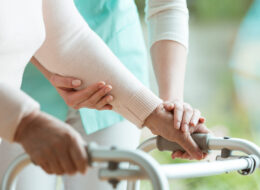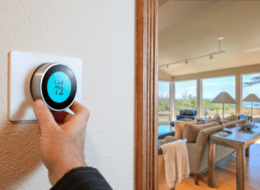Taking care of an elderly loved one can be both challenging and really rewarding. If your senior loved one needs help to get in or out of bed, it can be physically demanding, and even dangerous!
Many people don’t realize just how easy it can be for a caregiver to get seriously hurt when assisting a senior with heavy physical care. Muscles in the back, neck and shoulders become strained by repeated use, placing them at very high risk for injury.
Transferring a person from a bed to a wheelchair is one of the riskiest undertakings, in terms of caregiver injury. And unfortunately, all too often, these injuries become chronic conditions that never fully go away.
It’s also possible to hurt seniors during transfers. Skin tears and bruises are far too common, and bones can easily become dislocated or fractured.
Fortunately, there is a lot that can be done to reduce the risk to both caregiver and senior! By following safe procedures with proper body mechanics – and using the right equipment the right way – you can drastically reduce the chance of accidentally hurting yourself or the one you love.
Taking the time to learn how to help an elderly person get out of bed safely is a smart move, so let’s get into it!
Caregiver Techniques for Getting a Senior Out of Bed
It’s important to allow and encourage your senior loved one to do as much as possible for themselves, or at least to help you to the extent they can. This helps them preserve their strength and abilities to the extent possible, and takes some of the physical demand off of your shoulders.
Be sure to communicate well with the senior, and any others who may be helping. Tell them what you are doing, be clear about how they can help. Count to three to coordinate actions.
If the elder you’re assisting has dementia, it can be hard for them to remember all of the steps in the sequence of getting out of bed. You can help a lot by breaking it down into simple steps, and walking them through the process one step at a time. This can avoid overwhelming or confusing them, and enables them to participate to the greatest degree possible.
Step 1: Safety First – Create a Safety Checklist
Get in the habit of looking for dangers before you begin. By thinking through what you will do from start to finish, you won’t end up scrambling in the middle of the process to figure it out.
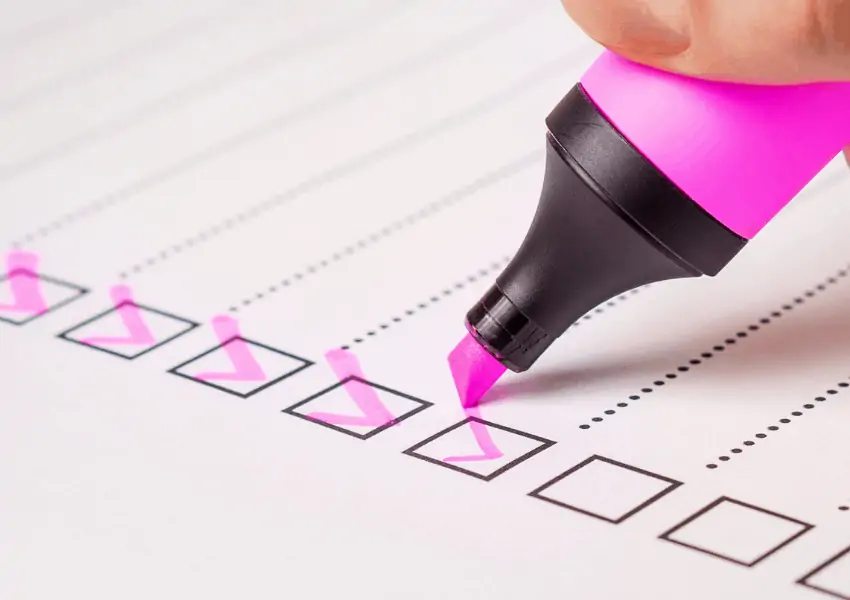
Communicate and coordinate with your loved one to the extent possible, so you both know what to expect from one another. You may even want to consider creating a written or mental checklist that includes the following safety checks:
- Wheelchair should be locked and positioned correctly
- Any equipment or supplies you may need are within easy reach
- There’s nothing on the floor that you can slip or trip on (such as water, powder, pillows, blankets, cords or pets)
- Both you and the senior should be wearing non-slip footwear. Solid, non-slip shoes or slippers are by far the best. If they aren’t an option for some reason, non-slip socks are better than nothing.
- Ensure any equipment you are using is functioning correctly, and fitted or adjusted to the person’s height or size appropriately.
- If you are using equipment, be sure you know how to use it properly! Ideally, you should consult with a physical therapist for personalized recommendations. Ask the person’s doctor about a referral for mobility or safe transfers, and medicare or insurance may cover most of the cost of a home visit.
Step 2: Getting a Senior Out of Bed Safely

Once you’ve confirmed that the environment is safe using the checklist above, talk the elderly person through the following steps, assisting as needed throughout the process.
- Bend the person’s knees and place their feet flat on the mattress.
- Roll the individual onto their side so they are close to the edge of the bed. (If you are physically assisting, place one hand under their far shoulder, and the other under their far hip, to help roll them toward you).
- Have the individual grab onto a bed rail, or another support item, as they roll, if possible.
- While lying on their side, slowly slide their legs over the edge of the bed. (If you are helping, you can place one hand over their knees and pull toward you, with the other hand beneath their bottom shoulder, assisting them to rise).
Now that the senior is sitting up on the edge of the bed, there are different ways to assist them to stand up to walk or sit in a wheelchair, depending on the individual’s needs and condition.
Step 3: Helping a Senior Stand Up
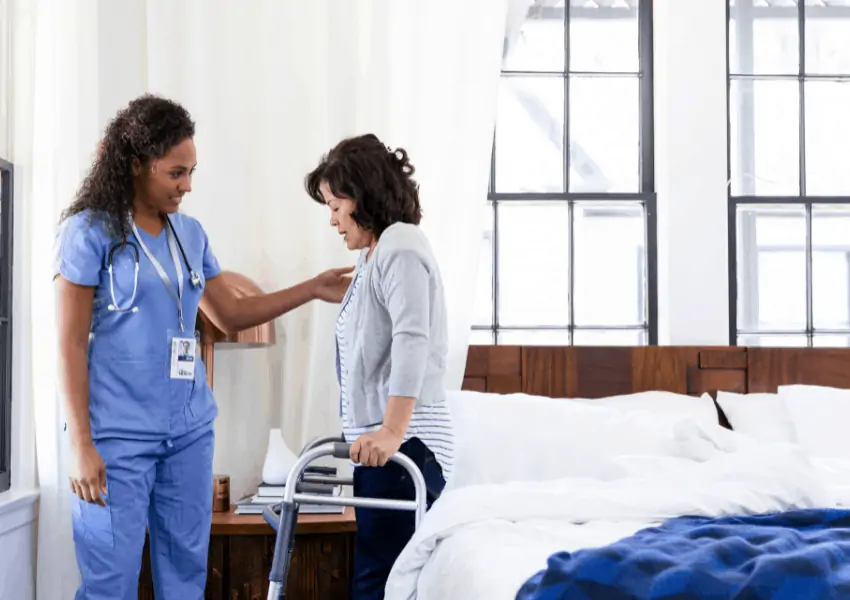
Ensuring the elderly individual’s feet and body are in the right position will make standing up much easier, whether you are helping them physically or not.
Use the following steps:
- Make sure the feet are all the way underneath their knees.
- Have the individual lean forward slightly with their “nose over toes”.
- Have them push up from the bed if possible, or use a bed rail or other supportive device to assist in standing up.
If you are physically assisting them to stand, use a transfer belt and good body mechanics (more on that below) at all times for everyone’s safety!
Step 4: Pivot Transfer from Bed to Wheelchair
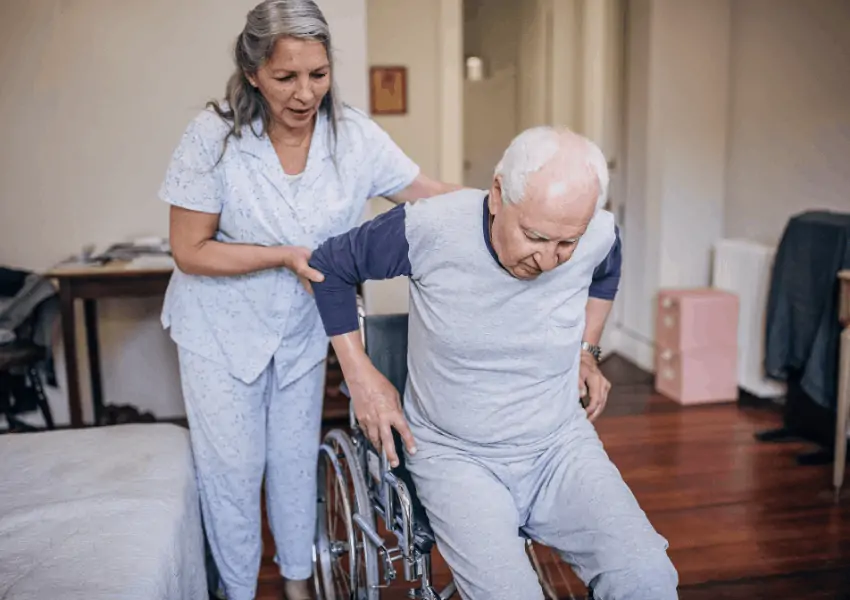
One of the most basic ways to physically assist a person from a bed to wheelchair is called a pivot transfer.
The steps to perform a pivot transfer are as follows:
- Ensure the wheelchair is right next to the bed, with the brakes locked.
- Put a transfer belt around the senior’s waist.
- Stand toe-to-toe with the individual, bend your knees a bit, and keep your back straight.
- Hold onto the handles of the transfer belt, with your palms toward you.
- Ask the patient to hold onto your waist, or your shoulders if necessary – never your neck!
- Ensure the senior’s feet are under their knees and ask them to lean forward – nose over toes.
- Count to three, rocking slightly with each count if you like.
- On “three”, support the senior as they stand up. You can pull up slightly on the transfer belt, but be careful not to bear too much of their weight. (If they can’t bear their own weight, you should consider a lift, transfer board or other equipment to assist).
- In a smooth motion, assist the senior to pivot around to the chair, and then lower them slowly into a seated position. (A pivot disc, described below, can help with the pivoting in some cases).
The Importance of Good Body Mechanics
The way that you hold and use your body is known as body mechanics – and they make a big difference when it comes to preventing an injury!
If you will be physically assisting your loved one out of bed, pay close attention to your body mechanics every time to reduce your risk of injury.
Start out by stretching your muscles a bit.
Do’s
- Keep your feet shoulder-width apart for a wide base of support
- Keep your back, head and neck aligned in a straight line – tucking in your chin will help
- Engage your core muscles (pretend you’re trying to make your belly button touch your spine)
- Keep the patient’s body as close to yours as possible
- Bend with your knees
- Lift with your legs
- Keep movements smooth and slow
Don’ts
- Don’t twist
- Don’t bend your back
- Don’t lift with your back muscles
- Don’t rush or resort to quick, jerky movements
- Don’t try to lift or transfer a senior who is too heavy, awkward or uncooperative.
If your senior loved one is too heavy, awkward or uncooperative – or if you feel unsafe for any reason – get help! You won’t be able to help them at all if you hurt yourself! It just isn’t worth the risk!
The Right Equipment for Bed Transfers Makes a Difference!
Having the right equipment can make all the difference in getting an elderly person out of bed safely!
There are many different types of equipment for elderly individuals with different needs. For safety’s sake, it’s very important that any equipment you use is appropriate for your specific situation, and that it’s used correctly.
There may be times when it’s helpful to use more than one type of equipment for a given situation.
We’ve broken down the most important pieces of bed transfer equipment into broad categories to make it easier to find what you’re looking for, but multiple categories may have something that would help in your situation.
Equipment for Seniors Who Need Just a Little Assistance
These little items may make a big difference in the amount of effort your loved one expends getting in and out of bed. While these items are helpful, they are only suitable for seniors who just need a little bit of extra stability or assistance getting out of bed.
Gait Aids: Canes and Walkers
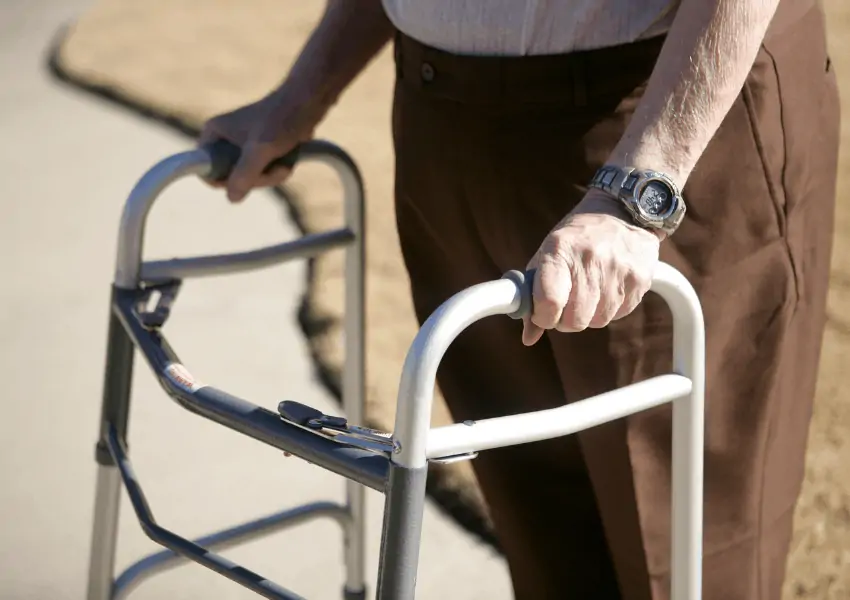
Gait aids, such as canes or walkers, won’t provide enough stability to meet some seniors’ needs, but they can be helpful for the older adult who needs just a little support to stand up from the edge of the bed.
Key takeaways:
- Offers a little support while standing up from edge of bed
- Use with caution to avoid an accident
- Portable and easy to use for travel
Gait aids increase a senior’s base of support and improve balance enough to make it easier to stand up from a sitting position on the edge of the bed.
These devices also help minimize stress on the joints, which can make standing up easier – and less tiring – when aches and pains interfere with a senior’s mobility.
Keep in mind that seniors should only push downward on the handles of their gait aid – they should never try to pull themselves up on a walker! Doing so can tilt the walker backward and increase the senior’s risk of falling.
Instead, consider a bed rail, transfer pole or other sturdy device designed for this purpose.
If using a walker with wheels, be sure that the wheels are locked before using the walker at the bedside so the wheels don’t roll unexpectedly, which can potentially lead to a fall.
When getting out of bed with a walker, push up against the bed, and then use the handles of the cane or walker for a little bit of balance support.
Gait aids can be an especially good choice for seniors who like to travel, because they can easily be taken along and used in motel rooms or other temporary lodging with minimal effort. A folding cane is especially easy to take along for travel, since in many cases, they can fold up small enough to fit into a handbag!
Bed Steps
For seniors who have trouble getting in and out of a bed that is too high, one solution may be bed steps. Bed steps are essentially stools with one or two steps leading up to the bed. Some bed steps even include handrails for extra support.
Key takeaways:
- Ideal for seniors with good balance and mobility who just have trouble getting into a high bed
- Size and portability varies from model to model
- Be careful about slipping off or tripping over bed steps
For more stability, look for a bed stool that has wide and deep platform dimensions. Smaller steps can make balance trickier, and a missed step can result in a serious fall.
Many people are groggy in the morning, or in the middle of the night, when they have to get up, contributing to the likelihood of a fall. Use bed steps with caution – and with a nightlight nearby!
Some bed steps come with handrails, which can add stability, or you can pair the bed steps with a bed rail or transfer pole for additional support.
Seniors who find their beds are too high may also consider buying a low profile frame, box spring, or mattress. Alternatively, you might lower the bed by removing any casters or wheels, or by cutting down wooden bed posts.
Furniture Risers
Many people don’t realize how much of an effect bed height can have on getting up! While some seniors may struggle with a bed that’s too high, others may run into the issue of having a bed that’s too low.
If a bed is too low, raising its height by even an inch or two can greatly reduce the effort it takes to get up on one’s feet – and it can be easier on achy knees as well!
Key takeaways:
- Increase the height of an existing bed to reduce effort needed to stand up
- Can help with knee pain in some cases
- Usually inexpensive and cost-effective
Furniture risers are small devices designed to slip under the legs of a bed frame to elevate the bed. They are much less expensive than purchasing a new bed, making them a popular fix for a low bed, but they’re not safe in every situation.
Risers should never be used with bed frames that have wheels or casters, and even without wheels, there is a risk the bed could slip off of the riser and injure someone. Choose a riser with features to enhance security, such as non-slip padding, or the ability to permanently mount the riser to the bedframe using screws.
Be careful not to raise the bed too high, or your loved one may have other types of trouble getting in and out of bed – like having to climb up or hop down… not safe!
When sitting on the edge of the bed with their thighs at about 90 degrees, a senior’s feet should be able to rest comfortably on the floor. If they can’t, the bed is too high. If their knees are higher than their hips, the bed may be too low.
Equipment for Seniors Who Have Medium to Poor Balance
A sturdy handhold can be essential for a senior with poor balance, and it can make sitting or standing up much easier.
Bed Rails
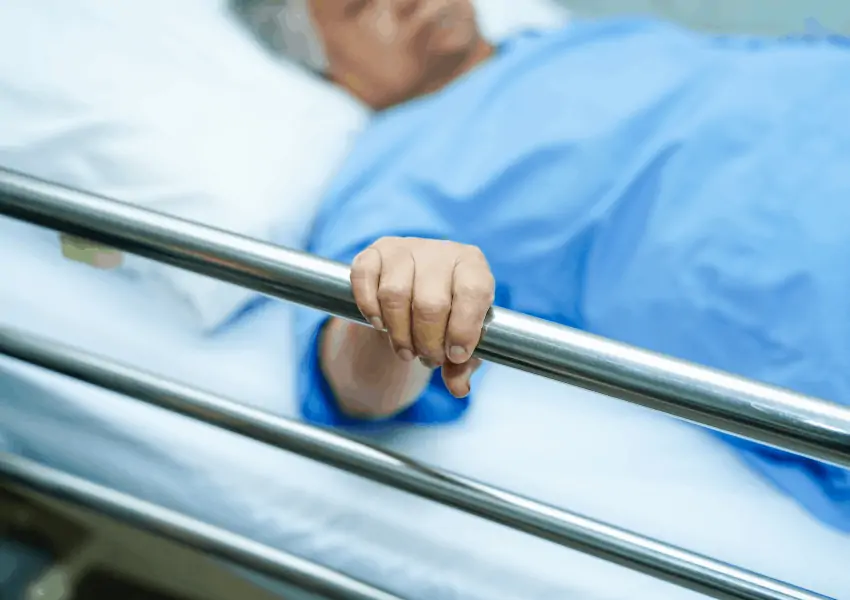
Bed rails are sometimes called bed assist rails, bed safety rails, side rails or bed handles. They attach to the existing bed frame or under the mattress.
Bed rails provide a sturdy handhold that a senior can grab when sitting up, rolling over, or moving about in bed, as well as when standing up.
Key takeaways:
- Provide a sturdy handhold to get in and out of bed, or pull self upright from lying
- May provide protection against accidentally rolling out of bed
- Lots of variety in features, sizes and styles
Some bed rails feature pouches or pockets to store essential items, such as a phone, TV remote control, medication, glasses, or a senior’s Kindle e-reader or book. These can be very helpful to seniors who spend a lot of time in bed, or have trouble reaching important items from the nightstand.
There’s a lot of variation in bed rail models. Some are short, located just near the upper part of the bed, while others run the whole length of the mattress. Some safety rails are lightweight and portable, while others are made for permanent installation, or heavy duty use by bariatric seniors.
Sometimes bed rails are used to prevent a senior from rolling out of bed, but they should never be used to keep a confused person with dementia from getting out of bed, as they may try to crawl over the rail and experience an even worse fall than they otherwise would have!
Transfer Pole
A floor-to-ceiling transfer pole (sometimes called a safety pole or security pole) is a vertical pole that can be placed next to the bed to provide a sturdy handhold to help a senior stand up.
Key takeaways:
- Can be placed almost anywhere
- Installation is usually easy (especially on standard flat ceilings)
- Some have crossbars or handles for additional support options
Many transfer poles are held in place with tension, and can easily be installed almost anywhere. Some transfer poles are screwed into the ceiling for an extra-sturdy or permanent placement. Ceilings that are slanted or very high may require specially designed poles and installation will be more involved.
Some transfer poles have horizontal crossbars, or curved handles, which can be easier for some seniors to grab on to.
Grab Bars
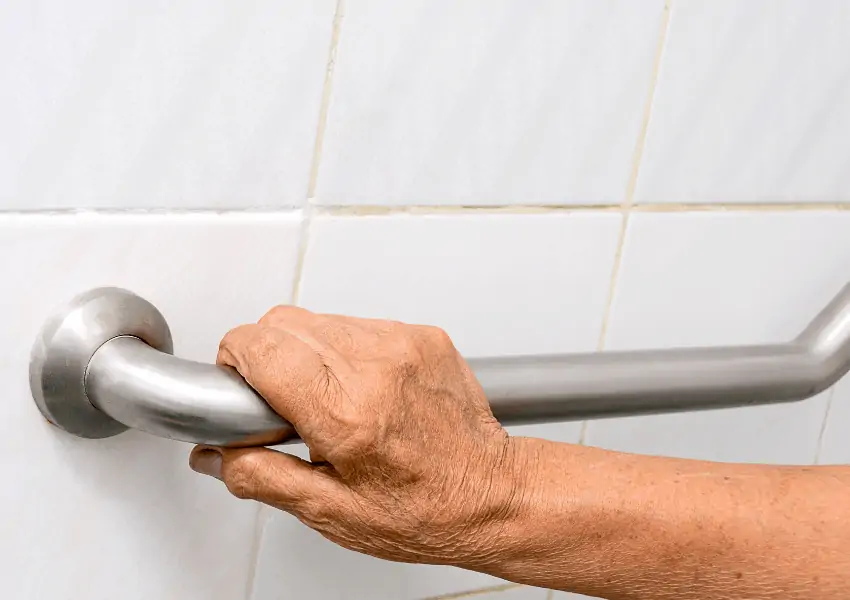
Grab bars are sturdy devices designed to bear a good deal of weight, providing excellent support even for seniors who may be quite weak or heavy.
Key takeaways:
- Very sturdy support
- Fold-down or fold-out models tend to work best in bedroom settings
- Installation can be expensive or cumbersome
Grab bars can be expensive and cumbersome to install. They must be carefully installed in the studs of the wall to ensure they are sturdy and safe. Because of their limited placement options, they often don’t work well at the bedside.
However, there are some grab bar models that fold down or out to offer a wider area of support.
There are also some floor-to-ceiling transfer poles that essentially have grab bars attached to them, which create much more flexibility in placement.
Equipment for Seniors who Have Trouble Moving Their Legs
Seniors who have partial paralysis, who have undergone recent surgery, or who have trouble moving their legs for other reasons may find these innovative devices to be quite helpful.
Pivot Discs
A pivot disc can be a useful tool for seniors who can stand up, but can’t easily move their legs.
Pivot disks are flat discs that are placed on the floor under the senior’s feet. The senior stands up on the disc, and then the helper assists them as they pivot to sit in the nearby seat.
Key takeaways:
- Ideal dor seniors who can stand up, but can’t easily move their legs
- Can be used independently or with caregiver support
- Portable and great for travel
Seniors with sufficient upper body strength can use the disc independently, along with a floor-to-ceiling transfer pole or bedrail.
If you will be physically assisting your loved one with the pivot disc, it’s recommended to also use a transfer belt, which provides a comfortable handhold for you to support your loved one safely.
Leg Lifters
Seniors who have had a hip replacement, a paralyzed leg, or limited range of motion in their lower body may benefit from the use of a leg lifter.
Key takeaways:
- Ideal dor seniors who can’t easily move their legs
- Inexpensive
- Portable
A leg lifter is a simple strap-like device with a loop that fits around the foot and a hand grip at the other end. This enables the senior to use their arm strength to lift their leg up onto a bed, a wheelchair footplate, a bathtub lift, into a car, or wherever needed.
Some leg lifters include multiple lifting loops, which allows the senior to use both arms to lift – this is helpful for those with less upper body strength. Leg lifters with rigid foot loops are best for seniors with poor dexterity, because they stay open on their own accord.
These simple, inexpensive and easily portable devices can greatly improve independence for seniors with poor mobility in their lower body.
Sliding Transfer Board
A sliding transfer board is a simple, inexpensive board made to assist individuals who can’t stand or use their legs well. The board is placed between two solid surfaces to make a bridge, enabling the senior to slide from one spot to the other.
Key takeaways:
- Ideal dor seniors who have difficulty moving their legs
- Not for use by those who can’t sit up independently, or who are sleepy or dizzy
- Can be used independently in some cases, but it is easier with a caregiver’s help
To get out of bed with a transfer board, a senior sits up on the edge of the bed with the wheelchair as close as possible, facing the bed. The board is placed between the bed and wheelchair with plenty of overhang on either side.
The senior moves their bottom onto the board, leans their trunk forward and then slides their bottom along the board into the chair, with the caregiver helping as needed.
It’s a good idea to consult with a physical therapist prior to using a sliding board to be sure you’re performing this transfer safely in your specific situation.
Equipment for Seniors Who Need Help Sitting Up
Seniors who find it difficult to sit up from a lying position are in good company. Many seniors struggle with this, and luckily, there are an array of helpful items to choose from.
If you haven’t already, be sure to look through the section on sturdy handholds above for more equipment that can help seniors who need help to sit up in bed.
Bed Ladder (Bed Rope Ladder)
Bed ladder straps, sometimes called bed rope ladders or bed pull ups, are designed to assist seniors or individuals with mobility challenges to pull themselves upright in bed independently.
Key takeaways:
- Use upper body strength to pull self up to sitting, or reposition self in bed
- Portable; easy to install and remove
- Inexpensive
Bed ladders are inexpensive, simple to use, and are easily portable. They attach to the legs or footboard of virtually any type of bed and can be installed or removed in mere moments.
Bed ladders are made from strong fabric, and feature several sets of hand grips from one end to another. Many resemble a rope ladder, although there are a number of styles on the market.
To use a bed ladder, the senior grabs the closest hand grip, and pulls themselves upright with their upper body strength, working their way from one handhold to the next.
Once the senior is sitting upright, it’s usually easier for them to slide their legs over the side of the bed to rise, perhaps with the support of a bed rail or transfer pole.
Bed ladders support bed independence and promote upper body strength by enabling the senior to use their muscles. Some bed ladders are also designed to assist the user to independently adjust their sleeping position.
Foam Bed Wedge
A foam bed wedge is a triangular pillow that can be set on top of the mattress to elevate a senior’s head and upper body.
Key takeaways:
- Elevate the head to reduce the struggle to sit up
- May be beneficial for seniors with breathing difficulty or GERD
- Portable
Foam bed wedges can be helpful for seniors who struggle to sit up from a lying position.
By starting from a 45-degree angle, the senior has less gravity to overcome, and much less work to do to sit up! This can be a big help for seniors with weak core muscles or poor arm strength.
Some seniors who benefit from raising the head of their bed while they sleep for other reasons – such as those who have GERD or difficulty breathing – may find this to be a suitable alternative to an electric bed. It’s certainly much less expensive – and it can be portable enough to toss in the trunk and take along for vacation!
Foam bed wedges can be used in conjunction with a bed rail or other device, if desired, for multiple levels of assistance.
Bed Trapeze Bars (Lifting Poles)
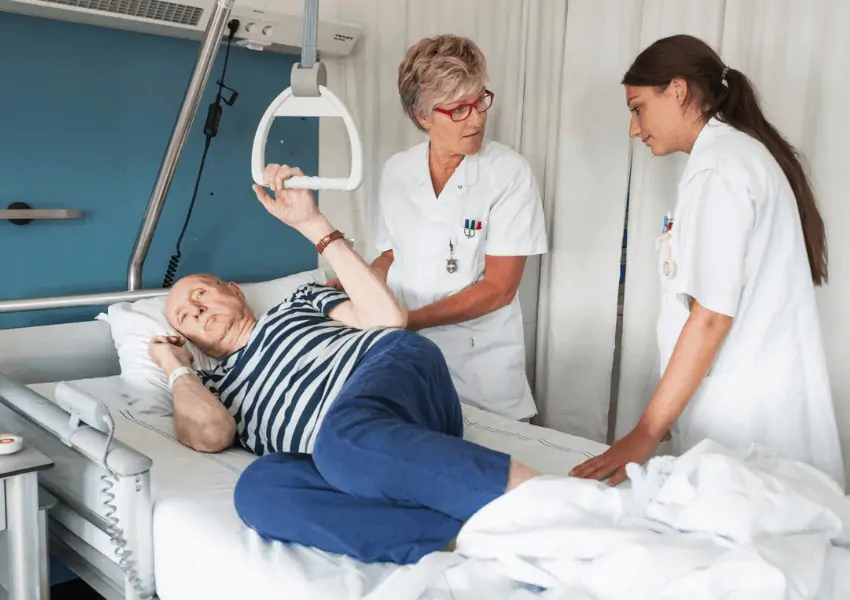
Bed trapeze bars, sometimes called lifting poles, can be very useful for seniors with good upper body strength who spend a lot of time in bed.
Bed trapeze bars can help seniors adjust their position independently, participate more easily in bed-based care (such as using a bedpan) and provide leverage to make it easier to sit up from a lying position.
Key takeaways:
- Ideal for seniors with good upper body strength who spend a lot of time in bed
- Can help a senior reposition themselves
- Can be used for upper body exercise
Bed trapeze bars typically feature a triangular shaped handhold suspended from a weight-bearing bar above the bed. Some trapeze bars attach to the bed frame itself, others to the ceiling, and the rest are designed to be freestanding.
When a senior is able to pull themselves up to sit, or otherwise help with the transfer process, it can relieve a lot of strain on the caregiver – and it can reduce the chance for injury to either party. Increased independence can also be better for the psyche!
Trapeze bars can also be used for in-bed pull-ups, or other exercises to build strength in the torso or upper body.
Equipment For Seniors Who Need a Mechanical Lift
Seniors who need extensive physical assistance to get out of bed may be best served by investing in a mechanical lift.
Mechanical Standing Lift
Standing lifts, also called sit-to-stand lifts, are designed to safely assist seniors with transfers in and of a bed, wheelchair, toilet or other seat.
Key takeaways:
- Eases caregiver-assisted transfers between bed, wheelchair and toilet
- Must be able to stand and bear weight to a certain extent
- Can be pricey
Mechanical standing lifts generally come in two parts: a sturdy frame and a padded sling. The frame includes footplates for the senior to stand on, and handles for them to hold onto. The sling wraps around their chest and attaches to the frame to support part of their weight.
The caregiver uses the remote control pad to engage the lift, and it slowly assists the senior to their feet. They stand up on the lift footplates, protected from falls by the sling. The lift is on wheels, and the caregiver can then maneuver the lift to a nearby destination.
Standing lifts can greatly reduce the effort required from both the senior and the caregiver, and drastically reduce the risk of injury as well (if used correctly)!
Although they can seem pricey at first glance, the price pales in comparison to a single hospital bill (not to mention the impact on comfort and quality of life!) from a fall that could have been prevented.
It’s important to note that the senior must be able to bear at least some of their own weight to use a standing lift. The exact amount of weight varies by model, but if they can’t stand up adequately they run the risk of serious injury. They will need a total body lift instead.
Total Body (Hoyer) Lift
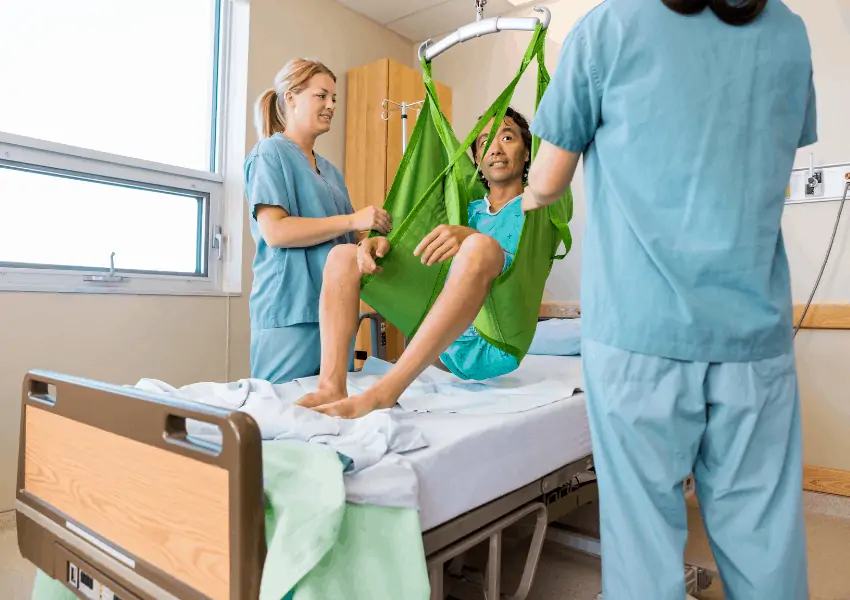
Total body lifts, which are also called Hoyer lifts, floor lifts or patient lifts, come in a few different styles. What they all have in common is that they are able to support a senior’s full body weight and safely transfer them from bed to chair or back again.
Key takeaways:
- Supports a senior’s full weight with no standing necessary
- Can be used to pick up someone from the floor after a fall
- Can be expensive
Total body lifts come with a sling, which must be properly positioned underneath the senior while in bed. Portable total body lifts usually feature a U-shaped base on wheels, and a horizontal bar where the sling can be attached.
Once the sling is attached, the bar (along with the senior) is raised via electricity or hydraulic power into the air. The elderly senior can then be wheeled a short distance to a chair, where they can be lowered and positioned comfortably.
Most of these lifts can be lowered all the way to the floor, if needed, which makes them indispensable in lifting a fallen senior up from the ground (never lift a senior with possible injuries with a lift – call 911 or your emergency responders instead).
Total body lifts aren’t cheap, but they can enable a bed bound senior to get out of bed, which can powerfully impact their comfort, skin health, and quality of life.
Equipment for Seniors Who Need a New Bed
Seniors who find their bed is too high or low should take a look at the sections on Furniture Risers and Bed Steps, above.
Seniors who need a new bed often find that an electric adjustable bed is a sound investment based on their current needs – or projected future needs.
Adjustable beds can usually be rented from a medical supply store if they are needed for just a short time.
Electric Adjustable Bed
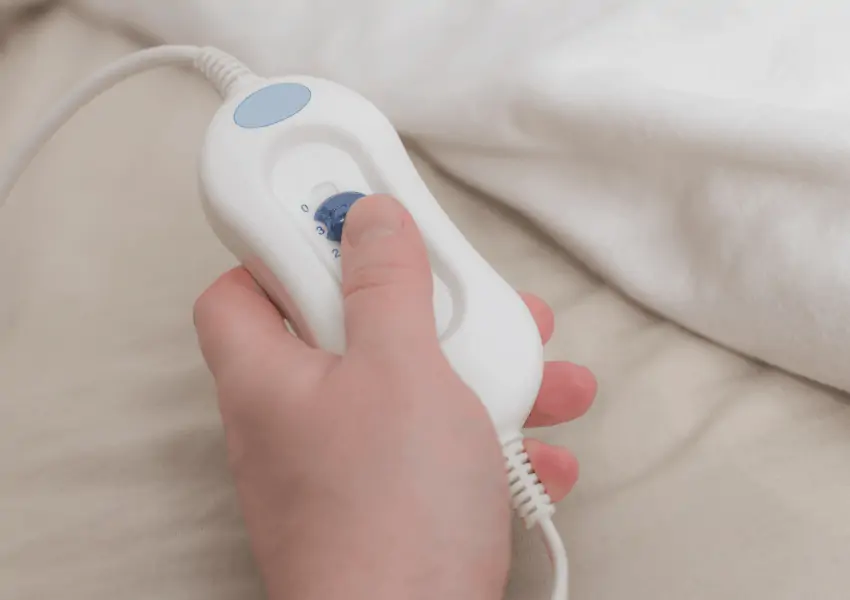
An electric adjustable bed can be helpful for seniors who have difficulty getting up in two main ways: they allow the head of the bed to be elevated at the touch of a button, and the entire bed can be raised or lowered to an ideal height as needed.
Key takeaways:
- Ideal dor seniors who have general weakness, breathing difficulty or circulatory issues
- Adjust the height of the entire bed to facilitate getting in and out safely
- Often comes with bed rails for added security and support
Raising the head of the bed can make it easier for a senior to get up, because once up, it’s simply a matter of sliding the legs over the side of the bed.
Raising the head of the bed is also helpful for those who have trouble breathing, or difficulty with heartburn or GERD. These beds can also raise the knees or elevate the senior’s feet, which is especially useful for those with swollen ankles or circulatory issues.
Raising or lowering the entire bed makes it convenient to find the ideal height for your loved one. A bed that is too high is hard to get into and dangerous to get down from. It takes a lot of extra energy to stand up from a bed that is too low, and it can be hard on the knees.
Most electric beds also come with bed rails attached, which can provide a sturdy handhold to assist in getting up or down, or even just adjusting their position in the bed.
Medical / Specialty Bed
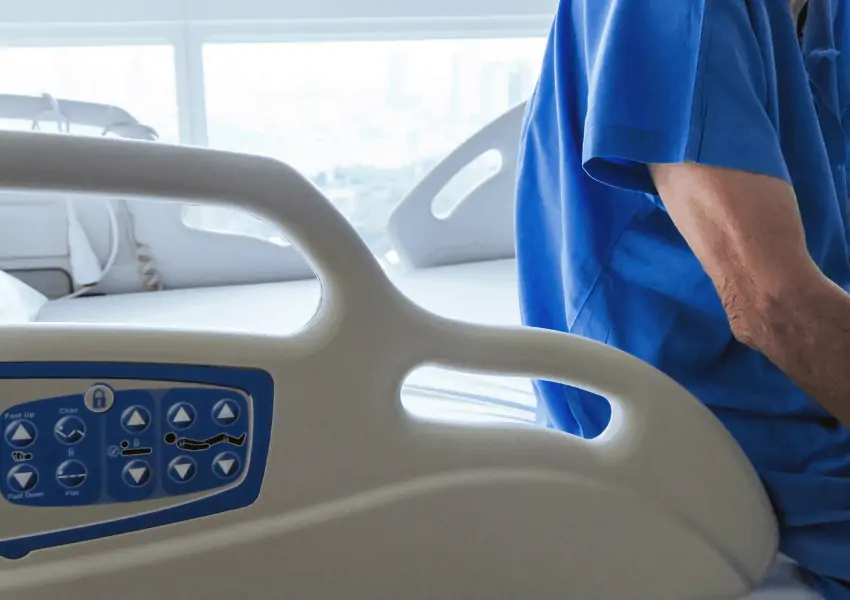
Medical or speciality beds are available to meet a wide range of customized mobility or medical needs.
Key takeaways:
- Ideal dor seniors with intense medical or mobility needs
- Should be used with medical guidance
- Can be very expensive
Some specialty beds help relieve pressure to reduce the risk – or enhance healing – of pressure ulcer bed sores, which can be very important for seniors who are bedbound or have difficulty moving in bed.
Bariatric specialty beds are extra large and durable to support the needs of heavier individuals.
Other specialty beds offer a wider array of positions than standard electric beds, which are designed to relieve symptoms of various medical conditions.
If a senior requires a specialty bed, their doctor or medical team should be involved in determining which bed is appropriate to meet their needs.
Transfer Belt: A Must Have for all Caregiver-Assisted Transfers
A transfer belt is a soft, strong, wide nylon belt with handles that can be snapped into place around a senior’s waist before standing up to transfer.
Key takeaways:
- Provides leverage and handles to assist with safe transfers, preventing falls and injuries
- Comfortable and easy to use
- Inexpensive
The handles provide safe handholds for the caregiver to grab from various angles, which provides excellent leverage in assisting the senior to stand, and to keep their balance while on their feet.
If the senior’s legs should give out, or they should start to fall, the transfer belt enables the caregiver to safely and easily correct their position and either prevent a fall, or safely lower them to the ground without injury (as long as the caregiver is using good body mechanics, as described above, the potential for injury is minimized).
Transfer belts help prevent injuries to seniors as well as to their caregivers, and are available at a very inexpensive price.
Lift Recliner Chairs – an Alternative to a Traditional Bed
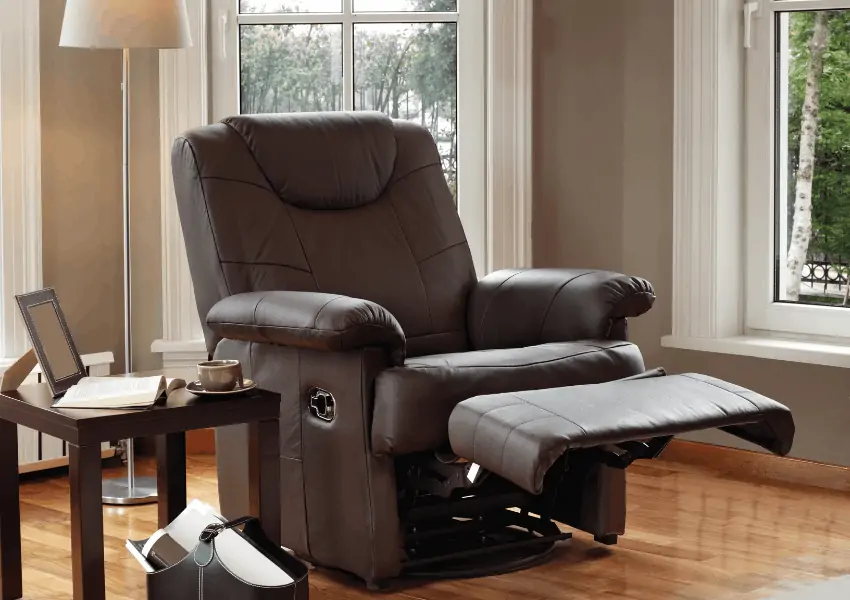
Some seniors find that it’s more comfortable to sleep in a lift recliner chair than a bed – and it can be much easier to get in and out of!
Elderly people with back pain, sleep apnea or GERD are among those most likely to prefer a recliner to a bed.
Infinite position chairs, or zero-gravity position chairs, are generally the most comfortable for sleeping in – and some come with lumbar heat, massage functions or other luscious luxuries that can promote relaxation and a good night’s sleep!
A Physical Therapy Evaluation can Help Choose the Right Equipment for You
It’s a good idea to check with your loved one’s doctor about any equipment that you will be using for bed mobility or transfers.
You can ask the doctor about having a physical therapist visit your senior loved one right in the home. They can assess their needs and make recommendations about which equipment will work best in your unique situation.
A physical therapy evaluation is definitely a smart investment – and a lot of the time Medicare (or other insurance) will even cover the costs!
Physical therapists can also recommend customized exercises that can make it easier for an elderly person to get in and out of bed.
Exercises That Can Make it Easier for a Senior to Get Out of Bed
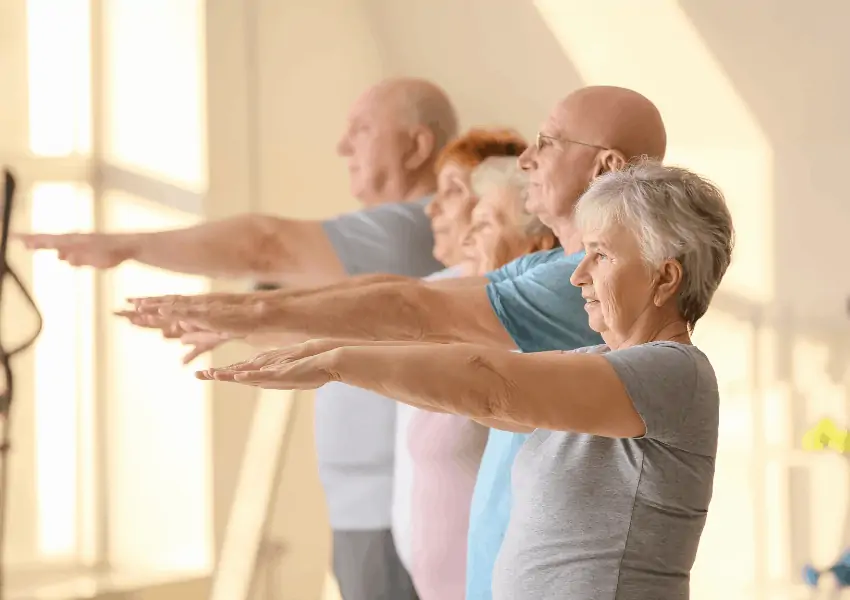
It’s much easier to maintain the strength and mobility you have, over trying to rebuild lost strength, and this holds true for seniors for sure!
Exercising specific muscle groups can make a big difference in a senior’s mobility. To that end, we’ve provided some examples of exercises that may help maintain or improve strength in key muscle groups needed for getting out of bed with the minimal assistance possible.
Seniors should always consult their doctor before beginning any exercise program – and it doesn’t hurt to ask if working with a physical therapist would be beneficial! This is especially important if the senior has a lot of trouble with mobility, or if there has been a rapid change in their ability to get in and out of bed.
1. Bridging to Increase Lower Body Strength
Bridging is a simple exercise which can strengthen the muscles of the buttocks and make it easier to turn over or move in bed.
- Lie on your back, with both knees bent
- Lift up your bottom and hold it up for 3 seconds, then lower it
- Repeat 8 times
Many people find that bridging twice a week can improve or maintain their strength and mobility.
2. Core Strengthening to Improve Core Stability
Strong core muscles in the lower torso are important for bed mobility, and can also protect the back from strains and injuries.
To improve core strength:
- Lie on your back, with both knees bent
- Contract your core muscles by pulling your belly button towards your spine
- WIth the core muscles contracted, lift the left leg up and then lower it
- Continue to contract your core muscles, and repeat with the right leg
- Repeat 8 times
Twice a week is often enough to increase core strength.
3. Wall Push Ups to Build Arm Strength
Wall push ups can be an easy yet effective way to increase your arm strength, which is important for getting out of bed.
- Stand arm’s length from a wall, facing it
- Place both hands on the wall just below the height of your shoulders
- Pull your shoulder blades back and up
- Using your elbows only, lower yourself towards the wall
- Hold this position for 3 seconds, and then push yourself back up
Repeat wall push ups 10 times, twice a week.
4. Calf Pumps to Prevent Dizziness
Seniors often experience dizziness when sitting or standing up from a lying position. This is because blood pressure can become slower to adjust to position changes with age, certain medications and medical conditions. The result is that the blood doesn’t reach the brain quickly enough and an elderly senior can become light-headed or dizzy, putting them at a higher risk for falling.
By moving your feet up and down for 10 seconds before you get out of bed, you can get your blood moving and improve your circulation. This can make it easier – and safer – for seniors who tend to get light headed upon standing.
Getting Smart About Getting Out of Bed
The easiest way for most seniors to get out of bed is to:
- Roll onto your side
- Move legs over the edge of the bed
- Use arms to push your upper body up
This method uses gravity to help pull the legs downward, which in turn creates leverage to raise the upper body with minimal effort.
Remember to sit for a minute or two, and pump your calves before standing, to allow your blood pressure to stabilize and prevent dizziness.
Helping an Elderly Loved One Out of Bed Safely Takes Planning
Helping your elderly loved one out of bed – or enabling them to better help themselves – is sometimes an essential part of taking care of a senior at home. Taking the time to plan out how to do it safely can prevent injuries, reduce strain and pain and preserve precious energy.
- Plan ahead
- Ensure a safe environment
- Use good body mechanics
- Use the right equipment the right way
- Ask for help when you need it
We hope that this article has been helpful to you as you learn how to best help your senior loved one in and out of bed! Leave us your questions in the comments below and let us know how we can help you in your caregiving journey!

